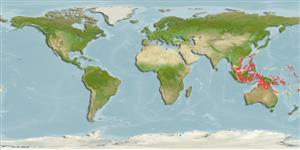Teleostei (teleosts) >
Kurtiformes (Nurseryfishes, cardinalfishes.) >
Apogonidae (Cardinalfishes) > Apogoninae
Etymology: Rhabdamia: Greek, rhabdos = stick + Greek, amia = a kind of shark (Ref. 45335); spilota: Name from Greek 'spilota' meaning spot, referring to the distinctive spot above the pectoral fin..
Environment: milieu / climate zone / depth range / distribution range
Ecology
Marine; reef-associated; depth range 20 - 55 m (Ref. 11894). Tropical
Indo-West Pacific.
Size / Weight / Age
Maturity: Lm ? range ? - ? cm
Max length : 6.0 cm TL male/unsexed; (Ref. 48635)
Dorsal spines (total): 7; Dorsal soft rays (total): 9; Anal spines: 2; Anal soft rays: 12; Vertebrae: 24. This species is distinguished by having D VI-I,9; A II,12; pectoral rays 13; total gill rakers on first arch 7+22; preopercular margin and ridge finely smooth; body very slender, depth 3.7-3.8 in SL; body semi transparent, whitish in life with 3-4 small dark spots midlaterally on operculum and above basal part of pectoral fin (Ref. 11894).
Swims in tight pairs (Ref. 48635); observed to occur in large aggregation around rocky outcrops with gorgonian fans and crinoids on steep slopes. Swims actively during the day above isolated coral heads to feed on zooplankton (Ref. 48635).
Life cycle and mating behavior
Maturities | Reproduction | Spawnings | Egg(s) | Fecundities | Larvae
Distinct pairing during courtship and spawning (Ref. 205).
Yoshida, T., K. Mabuchi and H. Motomura, 2018. Rhabdamia novaluna, a new species of cardinalfish (Perciformes: Apogonidae) from the western Pacific Ocean, with comments on the synonymy of Rhabdamia gracilis. Ichthyol. Res. 66(1):129-139. (Ref. 129520)
IUCN Red List Status (Ref. 130435)
Threat to humans
Harmless
Human uses
Tools
Special reports
Download XML
Internet sources
Estimates based on models
Phylogenetic diversity index (Ref.
82804): PD
50 = 0.5156 [Uniqueness, from 0.5 = low to 2.0 = high].
Bayesian length-weight: a=0.01122 (0.00528 - 0.02384), b=3.10 (2.92 - 3.28), in cm total length, based on LWR estimates for this (Sub)family-body shape (Ref.
93245).
Trophic level (Ref.
69278): 3.4 ±0.45 se; based on food items.
Resilience (Ref.
120179): High, minimum population doubling time less than 15 months (Preliminary K or Fecundity.).
Fishing Vulnerability (Ref.
59153): Low vulnerability (10 of 100).
